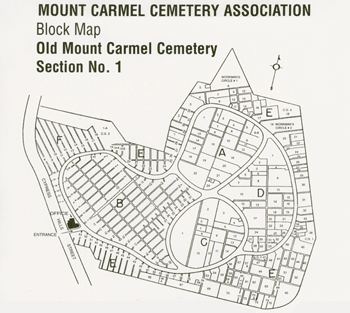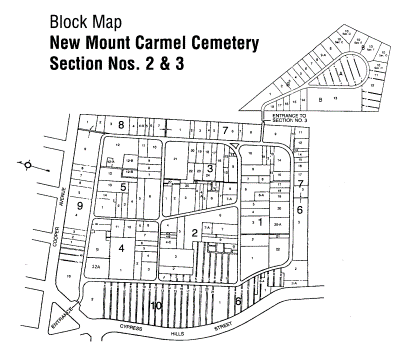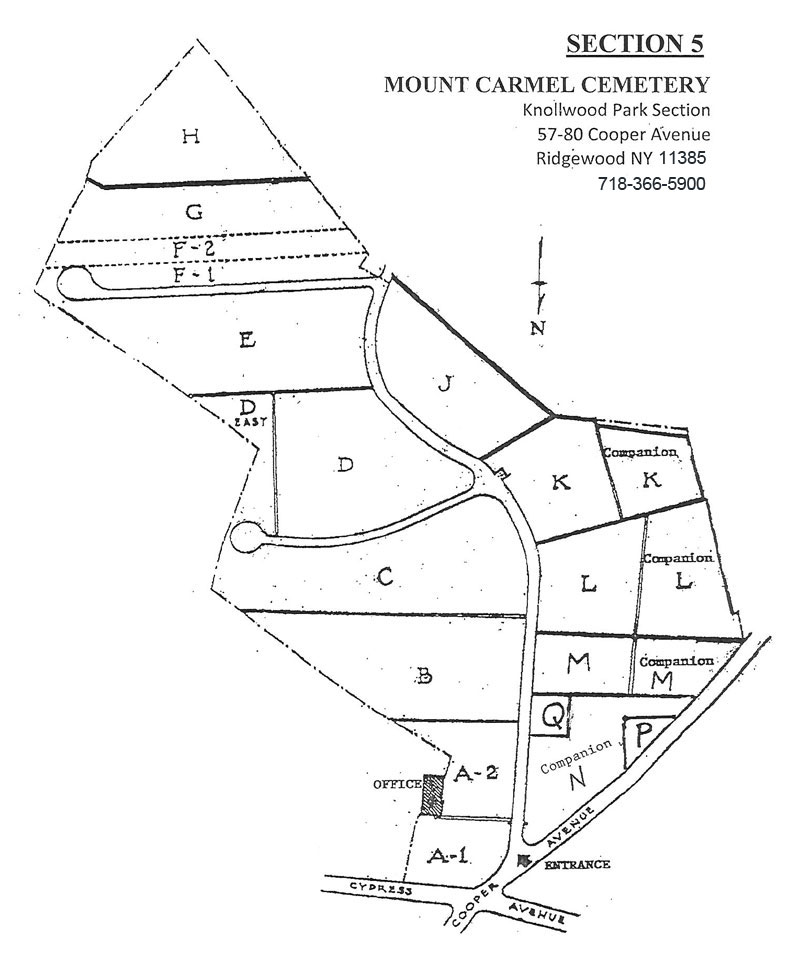

| Home | Hours Directions |
Interment Search |
Today's Interments |
Scheduled Unveilings |
|
About Mount Carmel Cemetery Named after the mountain of Bible lore, Mount Carmel Cemetery spreads over 100 acres near the border of Queens and Brooklyn. It is tastefully landscaped and beautifully maintained, but it is Mount Carmel's rich history that distinguishes it as one of the most important Jewish cemeteries in America. Founded a century ago, the cemetery's interments number more than 85,000. In addition to the thousands of beloved husbands and wives, fathers and sons, mothers and daughters, the cemetery serves as a final resting place to some of the most distinguished artistic and political voices in American Jewish history: Sholem Aleichem, Abraham Cahan, Morris Rosenfeld, Meyer London, Jacob Adler and others. Some of these names may not sound familiar, but each made enormous contributions to both Jewish and American life. Without a doubt, the cemetery's most famous resident is the beloved writer Sholem Aleichem (1859-1916). Born in Russia as Sholem Rabinovitz, he was one of the founding father's of Yiddish literature. During his lifetime he published dozens of novels, plays and short stories that recounted in poignant, folksy and often humorous detail, the trials and tribulations of Jews in the villages and small towns of the Old Country. The most famous of his stories involved the character of Tevye the Dairyman, and they were later adapted to create the play Fiddler on the Roof. At the end of his life, Sholem Aleichem moved to America, where most of his readership lived, and where he had become a symbol of the quickly vanishing shtetel of the Old World. His funeral in 1916 was the largest the city had ever seen at that time, drawing hundreds of thousands of Jews to the streets of New York. A horse-drawn hearse flanked by the greatest Yiddish writers of the day, led the funeral procession all the way from Harlem across the Williamsburg Bridge into Brooklyn. Mourners wept openly in the streets and windows, and one Yiddish daily described it as "a meeting-place for the children of the entire Diaspora." In his will, the writer expressed two wishes that were not ultimately granted. First, that he be buried in Kiev, Russia, which was not possible at the time so he now resides at Mount Carmel in a special enclave dedicated to the Workmen's Circle. Secondly, he requested that he be buried "among ordinary Jewish working folk," but as we will see, the writer's neighbors are anything but ordinary. Abraham Cahan (1860-1951), for example, was the founder and influential editor of the Jewish Daily Forward, which was in its day the most widely read Yiddish newspaper in the World. He argued vigorously in its pages for a vision of Jewish socialism, based on justice and equality. Also published frequently in the Forward was Morris Rosenfeld (1863-1923), the greatest of the "sweatshop poets," a group of turn-of-the-century writers who translated the suffering of the Jewish working class into poetry of deep poignance and revolutionary urging. Known as "a singer of labor," Rosenfeld once wrote, "The time-clock drags me off at dawn; at night it lets me go. I hardly know my flesh and blood..." If Rosenfeld gave the workers a poetic voice, Meyer London (1871-1926), who also resides in the same row, gave them a political one. A leader of the famous garment worker's strike of 1910, he became the first socialist elected to the U.S. Congress. While London was advocating for worker's rights, Jacob Adler (1855-1926) was transporting them to distant imaginary worlds in the Yiddish theaters of Second Avenue. Adler was the single greatest Yiddish actor of his day, and he is buried at Mount Carmel near his wife, actress Sara Adler (1860-1953), who also starred in many productions. These are just a few well-known residents from the early days of Mount Carmel's history. More recently, their ranks have been joined by Bella Abzug (1920-1998), the fiery New York civil rights attorney who was the first Jewish woman elected to Congress in 1970; Henny Youngman (1906-1998), the beloved Jewish comedian and "king of one-liners;" and the actor George Tobias (1901-1980), known for his many film and television roles. Also of note at Mount Carmel is Leo Frank (1894-1915), whose lynching based on a false murder conviction, has gone down in history as one of this country's most infamous cases of judicial injustice. Taken together these famous lives stand for the different paths that Jews have taken in this century - through the worlds of politics, letters, the arts and entertainment - to make the "Goldena Medina", the Golden Land of America, feel more like home. Mount Carmel where they have ultimately come to rest with thousands of others, is not just another cemetery. It is a tribute to those lives, and to the richness of the American Jewish past. Societies at Mount Carmel Cemetery Click here to view a list of the societies at Mount Carmel  Click here for printable image  Click here for printable image  Click here for printable image |
Mailing Address Mount Carmel Cemetery Association P.O. Box 860093 Ridgewood NY 11386 Phone (718) 366-5900 Physical Addresses
Section 1
83-45 Cypress Hills St Glendale NY 11385 Sections 2 and 3 66-02 Cooper Avenue Glendale NY 11385 Section 4 82-99 Cypress Avenue and Cypress Hills St Glendale NY 11385 Section 5 Knollwood Park Section 57-80 Cooper Avenue Ridgewood NY 11386 Section 6 (former Mount Neboh) 82-07 Cypress Hills St Glendale NY 11385 |
| Copyright 2025 @ Mount Carmel Cemetery, All Rights Reserved | |